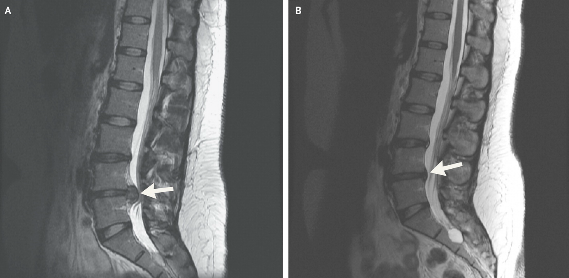Lumbar disc herniation has an uncertain natural history. Data from clinical trials suggest that patients who have herniated lumbar discs have similar long-term outcomes whether they undergo surgery or elect conservative management (i.e. physiotherapy). However too many people still take the surgical route instead of the less invasive, more cost effective conservative route. Hopefully these pictures with the accompanying story will help in our efforts to change this.
These images relate to a 29-year-old woman who presented to the spine clinic with new-onset pain in her right leg, accompanied by paresthesia. She reported that she began to have back pain after playing volleyball several years before presentation, whereas the pain and paresthesia in her leg began 6 months earlier and were not associated with a precipitating event. There were no bowel or bladder symptoms. Magnetic resonance imaging (MRI) of the lumbar spine revealed a lumbar disk herniation resulting in substantial spinal stenosis and nerve-root compression (Panel A, arrow). She elected conservative treatment with physical therapy and an epidural injection of glucocorticoids. A second MRI obtained at follow-up 5 months after presentation showed resolution of the herniation (Panel B, arrow). Her clinical symptoms resolved, and she was discharged from the clinic, with follow-up recommended as needed.
This story evidences a very positive story for conservative management of disc herniation. What experiences do you have in treating patients who have undergone surgery for similar conditions?
